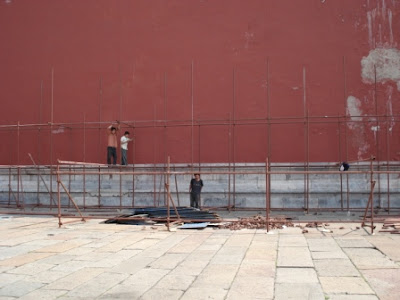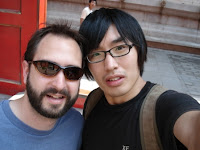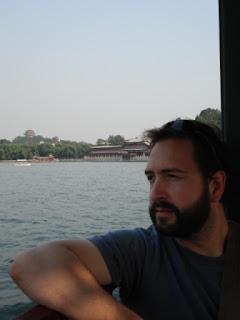 Everything is printed in Chinese! My actual blog site won't load at all so someone let me know how these are coming out.
Everything is printed in Chinese! My actual blog site won't load at all so someone let me know how these are coming out.Seriously though, everything is not in Chinese, plenty of signs are in English and the city is hot with Olympic fever. Beijing is almost as cool as Kyoto, and that's saying a lot coming from me. Besides needing to have your destination written out in Chinese characters for the Taxi drivers, Beijing is going to be ready for the Olympics. Other than the 90% of all people you meet trying to take advantage of you the place is great. I am still getting used to the idea that one must bargain for virtually everything and that a price tag often means very little when you have white skin.
The venerable Xiao Ouyang guided me through HuTongs and fried chicken bars, modern malls and, of course, the Imperial Palace itself. If not for Xiao I would have been lost many more times and the struggle would have been endless. However, many signs are printed in English now and Beijing is not a complex city. Everything spreads out from the Imperial Palace in regular blocks and the subway is pretty easy to navigate. The air isn't as bad as I expected, but in the morning it does feel a bit like you smoked cigarettes the night before. All in all I give Beijing an A minus as a world city (not that I'm an authority on world cities, but this is my blog so I get to do what I want.)
It is certainly an impressive place. Wow, I sound like I'm trying to sell a tour to Beijing or something.
Well anywayz, I will let the pictures speak, but maybe not for themselves:
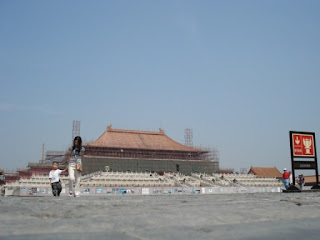
None of my pictures can give the sense of immense space created by the architecture of the Forbidden City.
There are at least six gates to the Forbidden City, which is a series of rectangles dividing rectangles surrounded by a huge moat, the Tongzi He. Each major gate opens into a gargantuan courtyard. Standing in the middle one can easily understand the impetus for director Zhang Yimou's Curse of the Golden Flower. An invading army, even if it got past the first two gates, would be in a continually worsening situation of being out in the open courtyard surrounded by high walls, which would have been filled with imperial archers. It is abundantly clear that the entire city was built as an extension of the masculine power of the Emperor. Zhang Yimou tries to express this patriarchal reality hoping that he shows what was wrong with the old imperial state, while showing the growing feminine strength to be associated with the people's revolt. But, just as in the movie where the Emperor survives to the last, being around the Chinese for even a short while convinces me that the rectangle and straight line are still very much the symbols of masculine dominion, and that the Imperial Palace still represents the Chinese ideal, however much may or may not have changed with the cultural revolution.
As you can see, there is a constant stream of tourists, mostly Chinese, crossing the bridge and entering the gates underneath the watchful eye of Mao. Xiao tried to get a pic of me up close but there were military personnel standing guard and they shewed us along. If you go to Beijing you will find there are many very helpful people around directing the swarming throngs of tourists. Xiao said maybe it was the American in him but it was a little weird to be watched all the time; I said it was very nice that the state cared so much for its citizens.
 Inside the Forbidden City there are all kinds of wonders to be found. Like this fake grass basketball court with a millitia on it. These guys were drilling while not 30 yards away there was a line of tourists going into a building labeled with a sign that said "Pictures of Eunuchs from the Imperial Palace." In 1813 it was the eunuchs who helped a revolting populace get far inside the walls of the Forbidden City. There were many eunuchs because the hundreds of courtesans had to be kept safe and untouched inside the walls.
Inside the Forbidden City there are all kinds of wonders to be found. Like this fake grass basketball court with a millitia on it. These guys were drilling while not 30 yards away there was a line of tourists going into a building labeled with a sign that said "Pictures of Eunuchs from the Imperial Palace." In 1813 it was the eunuchs who helped a revolting populace get far inside the walls of the Forbidden City. There were many eunuchs because the hundreds of courtesans had to be kept safe and untouched inside the walls.The People at Work: The Forbidden City is Under Construction
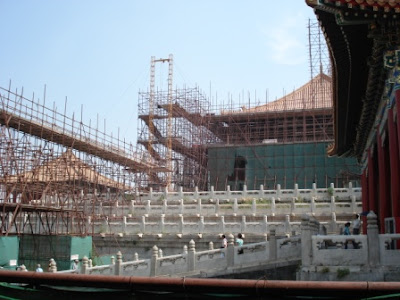
It probably took these guys half an hour to put one piece of scaffolding up. They didn't really look like they were paid very much. But there they were, representing the people working inside a place they never would have been allowed to even see. The amazing thing about the Forbidden City is that it is perfectly divided by an ancient road, parts of which only the Emperor and his mother were allowed to walk on. This central line of power is now the main route for tourists as they move in towards the Imperial Palace. There are huge courtyards surrounding the road, but they are almost completely empty of people because everyone stays on this one small stretch of cobble stones. Xiao believes this to be an excellent example of the Chinese people's attitude. People do not wander off in the larger areas even when the road is packed with people, because it is in the center line that power abides and it is there they are drawn from all sides of China. As Mao's picture at the gate declares their right to enter the "Forbidden City," so too their taking of pictures declares their place in the power structure.
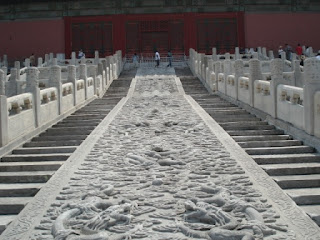
Some one thousand tons of stone went into the creation of this phenomenal single piece sculpture. In the foreground massive dragons duel each other.
An old man watches the Imperial Palace get older.

Once inside the living areas of the palace grounds, a maze of rooftops, courtyards and tiny rooms presents itself.
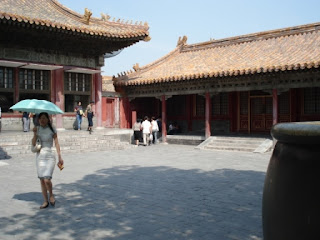
All the rooftops are fitted with these strange ornate figures:
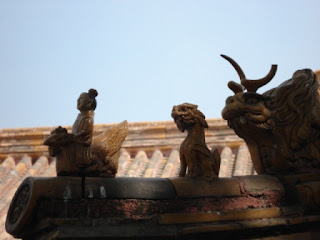
The Emperor's Inner Sanctum:
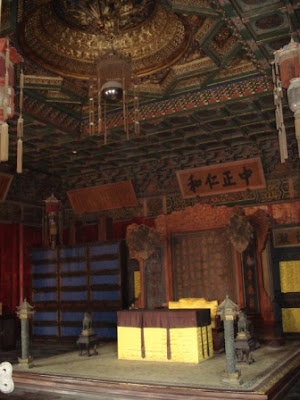
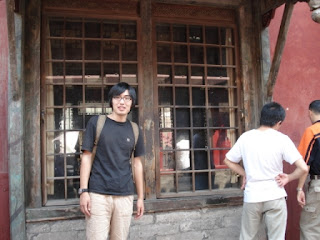 The Illustrious Guide Himself:
The Illustrious Guide Himself:
"I think I've got all I need: Nietzsche, Beckett, and cigarettes." Seriously though, I read most of Waiting for Godot while waiting in line at the Bank of China. It's going to be silly when the city is overrun with foreigners for the Olympics. In case you go, don't bother with so much traveler's checks, just use the ATMs from the Industrial and Agricultural Bank of China to withdraw Yuan. There's no point in going to the bank if you can avoid it. Also, most of the ATMs start in Chinese, but just press a button you think looks right and you'll get to a window that will allow you to choose English, then its easy.

The smaller buildings of the palace have amazing architecture and fine woodwork. The Chinese have repainted some of the larger buildings, but many are left with ancient peeling paint for added effect. Strangely enough, many of the small museum areas are newly painted on the outside, but the pieces on the inside are left with inches of dust on them. I would think that European and American curators cringe whenever they visit. We saw some ancient pieces that were just sort of sitting out in the open gathering dust.

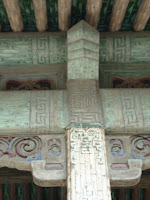
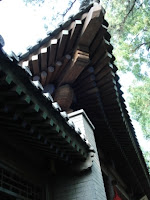
For the architecturally inclined. Most of these buildings have no nails or screws in them.
According to Xiao the architects wanted to create the sense of the wings of a bird as it takes off the ground. Unfortunately I couldn't get far enough away for a proper shot because there were so many other little buildings like this one, housing alters to various gods.
 The Imperial Gardens:
The Imperial Gardens: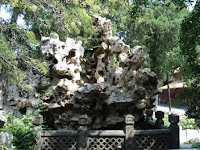
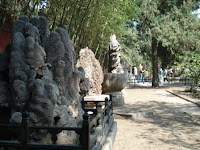
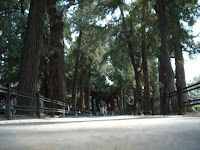
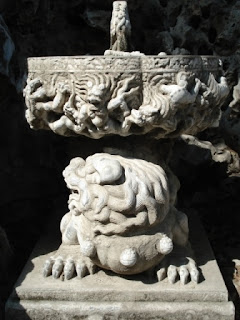
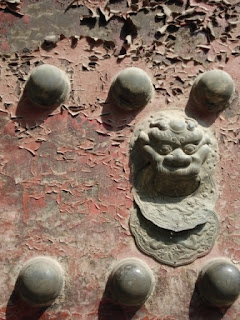
After leaving through the north gate Xiao and I hiked up Coal Hill to see the Forbidden City from above:
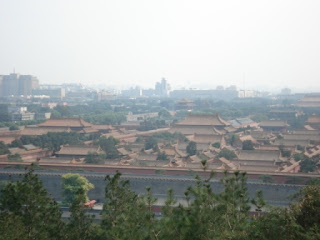
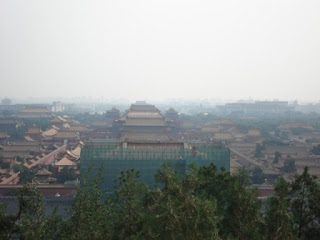
After leaving Coal Hill Park (Jingshan), we headed for Beihai Park via some excellent Szechuan chicken and vegetables. But we had to cross this:
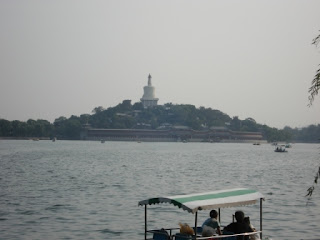 in order to get to this:
in order to get to this:
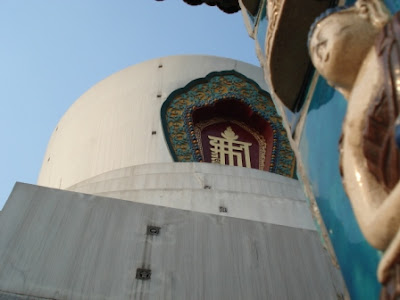 So first we stopped and saw the nine dragon screen...
So first we stopped and saw the nine dragon screen...
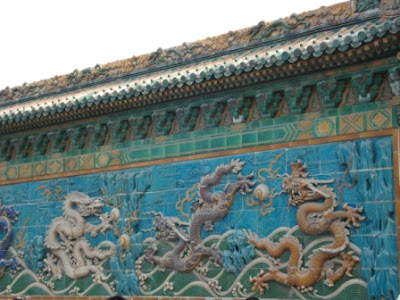

and then we took a boat ride...

Some one thousand tons of stone went into the creation of this phenomenal single piece sculpture. In the foreground massive dragons duel each other.
An old man watches the Imperial Palace get older.


Once inside the living areas of the palace grounds, a maze of rooftops, courtyards and tiny rooms presents itself.

All the rooftops are fitted with these strange ornate figures:

The Emperor's Inner Sanctum:

 The Illustrious Guide Himself:
The Illustrious Guide Himself:"I think I've got all I need: Nietzsche, Beckett, and cigarettes." Seriously though, I read most of Waiting for Godot while waiting in line at the Bank of China. It's going to be silly when the city is overrun with foreigners for the Olympics. In case you go, don't bother with so much traveler's checks, just use the ATMs from the Industrial and Agricultural Bank of China to withdraw Yuan. There's no point in going to the bank if you can avoid it. Also, most of the ATMs start in Chinese, but just press a button you think looks right and you'll get to a window that will allow you to choose English, then its easy.

Can you find me?
The smaller buildings of the palace have amazing architecture and fine woodwork. The Chinese have repainted some of the larger buildings, but many are left with ancient peeling paint for added effect. Strangely enough, many of the small museum areas are newly painted on the outside, but the pieces on the inside are left with inches of dust on them. I would think that European and American curators cringe whenever they visit. We saw some ancient pieces that were just sort of sitting out in the open gathering dust.



For the architecturally inclined. Most of these buildings have no nails or screws in them.
According to Xiao the architects wanted to create the sense of the wings of a bird as it takes off the ground. Unfortunately I couldn't get far enough away for a proper shot because there were so many other little buildings like this one, housing alters to various gods.
 The Imperial Gardens:
The Imperial Gardens:




After leaving through the north gate Xiao and I hiked up Coal Hill to see the Forbidden City from above:


After leaving Coal Hill Park (Jingshan), we headed for Beihai Park via some excellent Szechuan chicken and vegetables. But we had to cross this:
 in order to get to this:
in order to get to this: So first we stopped and saw the nine dragon screen...
So first we stopped and saw the nine dragon screen...

and then we took a boat ride...
and then we climbed through The Cave of Immortals...
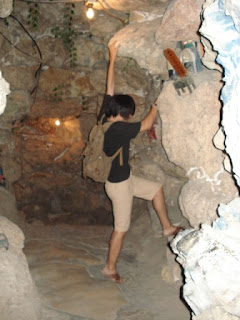

and then we saw a statue of Yamantaka, lord of death...

and then:
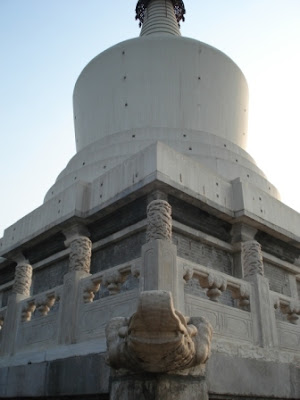
...we finally made it to the stupa.

Then it was time for more Chinese beer and chicken wings on sticks.


and then we saw a statue of Yamantaka, lord of death...

and then:

...we finally made it to the stupa.

Then it was time for more Chinese beer and chicken wings on sticks.

